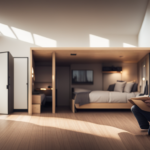Beginners Guides
Gifts For Someone Who Lives In A Tiny House
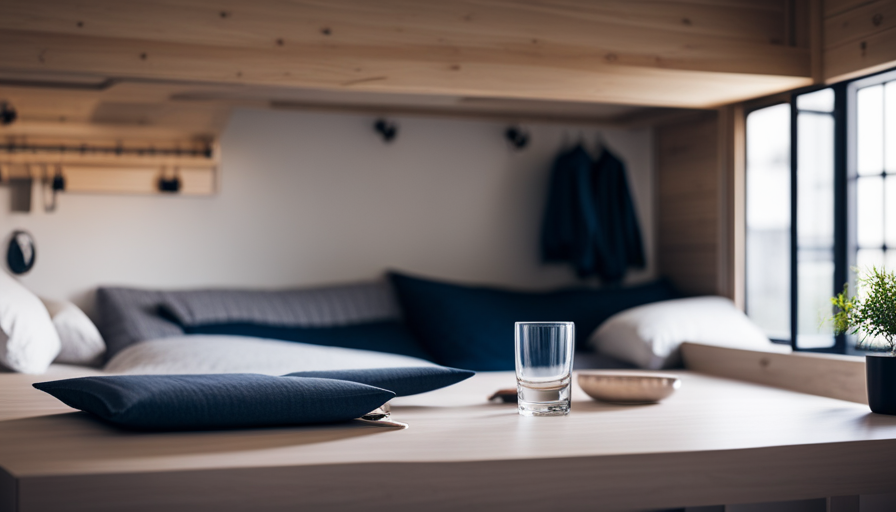
Dwelling in a small home is akin to exploring an array of opportunities within the compact dimensions of a shoebox. It serves as a wonder of space efficiency, an emblem of minimalistic lifestyle, and a snug sanctuary, all combined into a single entity.
But finding the perfect gift for someone who lives in a tiny house can be a daunting task. Fear not! I’m here to guide you through the maze of options and help you find the ideal present that will bring joy and practicality to their limited space.
From space-saving kitchen gadgets that make meal prep a breeze, to minimalist decor that adds a touch of style without overwhelming the space, there are plenty of options to choose from.
And let’s not forget about eco-friendly products that align with their sustainable lifestyle, outdoor living essentials that maximize their tiny outdoor space, organization tools that keep everything in its place, compact entertainment options to keep them entertained, and personalized touches that make their tiny house feel like home.
So, whether you’re shopping for a friend, family member, or even yourself, get ready to explore the world of gifts for someone who lives in a tiny house. Let’s make their small space feel like a big adventure!
Key Takeaways
- Space-saving kitchen gadgets like compact dish racks and collapsible measuring cups are great gift options for someone living in a tiny house.
- Minimalist decor, such as furniture with clean lines and hidden storage compartments, can add style without overwhelming limited space.
- Eco-friendly products, like sustainable cleaning supplies and reusable food storage options, are important for sustainable living in a tiny house.
- Compact entertainment options, such as mini projectors and wireless Bluetooth speakers, provide practicality and enjoyment without taking up much space.
Space-Saving Kitchen Gadgets
If you’re looking to surprise your friend who lives in a tiny house, you’ll definitely want to check out these awesome space-saving kitchen gadgets!
In a small kitchen, every inch of counter space is precious, so space-saving kitchen appliances are a must-have. There are so many innovative storage solutions out there that can help maximize the limited space.
For example, there are compact dish rack and drying mats that can be folded up and stored away when not in use. You can also find collapsible measuring cups and spoons that are perfect for saving drawer space. These gadgets not only save space but also make cooking and baking easier and more efficient.
Now, let’s move on to the next section about minimalist decor, where we can explore ways to make the most of the limited space in a tiny house.
Minimalist Decor
When it comes to decorating in a minimalist style, there are plenty of chic options available.
Minimalist furniture is a great way to create a clean and clutter-free look in a tiny house. Look for pieces that have clean lines and a sleek design, such as a minimalist sofa or a compact dining table. These furniture pieces not only save space but also add a touch of elegance to the overall decor.
In addition to furniture, small space storage is essential in a tiny house. Consider investing in wall-mounted shelves, floating shelves, or multi-functional furniture with hidden storage compartments. These options will help maximize the available space and keep your belongings organized.
Transitioning into the subsequent section about eco-friendly products, it’s important to consider items that are not only minimalist but also sustainable.
Eco-Friendly Products
When it comes to eco-friendly products, there are three key areas to focus on: sustainable cleaning supplies, reusable food storage, and energy-saving devices.
Sustainable cleaning supplies are not only better for the environment, but they also promote a healthier living space by reducing exposure to harmful chemicals.
Reusable food storage options, such as glass containers or silicone bags, help reduce waste and limit the use of single-use plastics.
Lastly, energy-saving devices like smart thermostats and LED light bulbs can significantly reduce energy consumption, resulting in both cost and environmental savings.
Sustainable Cleaning Supplies
Imagine walking into your tiny house and being greeted by the delightful scent of eco-friendly cleaning supplies. When living in a small space, it’s important to prioritize sustainability and minimize waste. That’s why sustainable cleaning supplies are the perfect gift for someone who lives in a tiny house. These products not only keep the environment in mind, but they also ensure that your tiny house remains clean and fresh without taking up unnecessary space. Take a look at this table to see some examples of sustainable cleaning supplies that are perfect for a tiny house:
| Product Name | Description | Benefits |
|---|---|---|
| Sustainable Laundry Detergent | Made with natural ingredients and packaged in recyclable materials | Reduces water and energy usage while still effectively cleaning clothes |
| Zero Waste Cleaning Spray | Refillable bottle and non-toxic formula | Minimizes plastic waste and keeps surfaces clean and safe |
| Biodegradable Dish Soap | Plant-based ingredients that break down naturally | Gentle on the environment and perfect for handwashing dishes |
These sustainable cleaning supplies are just the beginning of creating an eco-friendly and efficient tiny house. Now, let’s transition into the next section about reusable food storage.
Reusable Food Storage
Transitioning into the next section, let’s explore the convenience and sustainability of using reusable food storage in your compact living space.
When living in a tiny house, it’s crucial to maximize every inch of storage, and that includes your food containers. Reusable lunch containers are a fantastic option for storing leftovers, meal prepping, or packing snacks on the go. They come in various sizes and materials, such as glass or stainless steel, ensuring durability and easy cleaning.
Another eco-friendly alternative is silicone food bags, which are flexible, airtight, and safe for both the freezer and microwave. These bags eliminate the need for single-use plastic bags and are perfect for storing fruits, vegetables, or even liquids.
By incorporating reusable food storage solutions, you not only reduce waste but also save money in the long run.
Speaking of saving, let’s delve into the next section about energy-saving devices.
Energy-Saving Devices
When it comes to living in a tiny house, every inch of space and every ounce of energy counts. That’s why reusable food storage is essential, but it’s not the only way to make a tiny house more sustainable. Energy-saving devices play a crucial role in maximizing efficiency and minimizing environmental impact. Two popular options are smart thermostats and solar panels. Smart thermostats allow you to control the temperature of your tiny house remotely, ensuring that energy is not wasted when you’re not home. Solar panels, on the other hand, harness the power of the sun to provide clean and renewable energy. By incorporating these devices into a tiny house, you can reduce your carbon footprint and save money on utility bills. As we move on to the next section about outdoor living essentials, it’s important to consider how these devices can enhance your overall living experience.
Outdoor Living Essentials
With a cozy fire pit and a snuggly hammock, outdoor living in a tiny house becomes a tranquil retreat. When it comes to gifts for someone who lives in a tiny house, outdoor living essentials are a great choice.
Outdoor cooking equipment, such as portable grills or compact stoves, allow for delicious meals to be prepared al fresco. Compact gardening tools, like collapsible shovels and mini watering cans, help maximize the limited space while nurturing a small garden or potted plants. These essentials not only enhance the outdoor living experience but also provide an opportunity to connect with nature in a small space.
As we transition into the next section about organization tools, it’s important to find items that optimize storage and create a clutter-free environment.
Organization Tools
Get organized and make the most of your small space with these handy organization tools. When living in a tiny house, it’s important to maximize every inch of storage. Here are some must-have items to help keep your closet and bathroom tidy:
-
Slimline Hangers: These space-saving hangers are perfect for optimizing your closet. They take up less space than traditional hangers, allowing you to fit more clothes.
-
Over-the-Door Shoe Organizer: Utilize the back of your closet door with this versatile organizer. It can hold shoes, accessories, or even cleaning supplies, keeping them easily accessible and out of the way.
-
Under Sink Storage: Make the most of your limited bathroom space with under sink storage solutions. These shelves and racks provide extra space for toiletries, towels, and cleaning supplies.
With these organization tools, you’ll be able to declutter and efficiently store your belongings, making your tiny house feel more spacious. Now, let’s explore some compact entertainment options.
Compact Entertainment Options
When it comes to living in a tiny house, finding compact entertainment options is key. One great option is a mini projector, which allows you to enjoy movies and shows on a big screen without taking up much space.
Wireless Bluetooth speakers are also a must-have, providing high-quality sound without the need for wires or bulky equipment.
And for those who work or study from home, a folding laptop desk is a practical solution that can easily be stored away when not in use.
These three options provide entertainment and productivity solutions that are perfect for a small living space.
Mini Projector
Imagine yourself in your cozy tiny house, where space is limited but your imagination is boundless.
Picture a mini projector, a pocket-sized marvel that transforms your small living area into a captivating cinematic oasis. With a portable screen that can be easily set up and taken down, the mini projector allows you to enjoy your favorite movies, TV shows, and videos without sacrificing valuable space. Its compact design ensures that it seamlessly integrates into your compact home theater setup.
The mini projector provides a high-quality image and vibrant colors, delivering an immersive viewing experience. Whether you want to have a movie night with friends or enjoy a quiet evening alone, the mini projector is the perfect gift for someone living in a tiny house.
Now, let’s delve into the next section about wireless Bluetooth speakers for an exceptional audio experience.
Wireless Bluetooth Speakers
Now, let’s groove to the rhythm with wireless Bluetooth speakers for an incredible audio experience in your cozy abode. When it comes to portable headphones and waterproof speakers, there are a plethora of options that will fit perfectly into your tiny house lifestyle.
In order to help you make an informed decision, let’s take a look at a comparison table showcasing four top-notch wireless Bluetooth speakers:
| Speaker Model | Battery Life | Waterproof Rating | Price |
|---|---|---|---|
| Speaker A | 12 hours | IPX7 | $79 |
| Speaker B | 15 hours | IPX5 | $99 |
| Speaker C | 20 hours | IPX6 | $119 |
| Speaker D | 10 hours | IPX4 | $69 |
With these speakers, you can enjoy your favorite tunes anywhere in your tiny house, whether it’s in the kitchen, bedroom, or even outdoors. Now, let’s move on to the next section and explore the convenience of a folding laptop desk for your compact living space.
Folding Laptop Desk
To maximize your productivity and create a comfortable workspace, consider investing in a folding laptop desk that perfectly complements your compact living space.
A portable workstation like this is essential for anyone living in a tiny house, as it provides a dedicated area for work or leisure activities without taking up valuable space.
The adjustable laptop stand allows you to find the perfect height and angle for your laptop, ensuring optimal ergonomics and preventing strain on your neck and back.
With a folding design, it can easily be stored away when not in use, freeing up even more space in your tiny house.
Adding personalized touches to your workspace, such as a photo frame or a small plant, can make it feel more inviting and inspiring.
Personalized Touches
When it comes to adding personalized touches to a tiny house, there are a few key items that can make a big impact.
First, a customized doormat not only welcomes guests, but also adds a touch of personality to the entrance.
Second, an engraved cutting board can serve both as a functional kitchen tool and a sentimental piece that adds character to the space.
Lastly, handmade wall art can be a great way to showcase personal style and creativity, while also adding a unique focal point to the walls.
These small but meaningful additions can truly make a tiny house feel like a home.
Customized Doormat
Although living in a tiny house can be challenging, a customized doormat can add a touch of personalization and warmth to the limited space. A customized welcome mat not only serves as a functional item to wipe your feet on, but it also adds a unique and inviting element to the entrance of your tiny home.
You can choose to personalize the doormat with your family name, a favorite quote, or even a depiction of your small space garden. The options are endless, allowing you to truly make it your own.
Not only does a customized doormat make a great gift for someone living in a tiny house, but it also serves as a practical and stylish addition to their compact living space.
Moving on to the next gift idea, an engraved cutting board…
Engraved Cutting Board
Imagine the feeling of slicing through your favorite ingredients on a beautifully engraved cutting board, adding a touch of elegance and personalization to your culinary adventures. With engraved kitchen utensils, you can create a customized cutting board that not only serves its practical purpose but also becomes a unique piece of art in your tiny kitchen.
Picture yourself displaying the cutting board on your countertop, with intricate engravings that reflect your personality and style. As you prepare meals, you can glance at the board and be reminded of the special memories associated with it. Additionally, consider pairing the cutting board with a personalized recipe book, filled with your favorite recipes and family traditions. This combination of practicality and sentimentality is the perfect gift for someone living in a tiny house, where every item holds great importance.
Transitioning to the next section, let’s explore the idea of handmade wall art.
Handmade Wall Art
Crafting your own unique pieces of handmade wall art allows you to add a personal touch to your living space, creating a cozy and inviting atmosphere. When living in a tiny house, every inch of space matters, and having artwork that is not only visually appealing but also functional can make a big difference. One great option is to create unique tapestries using repurposed materials. These tapestries can be made from old fabrics, such as vintage clothes or scrap pieces of fabric, giving them a one-of-a-kind look. By repurposing materials, you not only reduce waste but also create a conversation piece that showcases your creativity and resourcefulness. To help you get started, here is a table showing different repurposed materials you can use for your handmade wall art:
| Material | Description |
|---|---|
| Vintage clothes | Old clothes with unique patterns and textures |
| Scrap fabric | Leftover fabric pieces from other projects |
| Wood scraps | Discarded pieces of wood that can be painted or stained |
| Bottle caps | Colorful and unique bottle caps that can be arranged |
| Old magazines | Pages from magazines that can be collaged or cut into shapes |
Get creative with your handmade wall art and let your imagination run wild. The possibilities are endless when it comes to repurposing materials to create beautiful and unique wall decor for your tiny house.
Frequently Asked Questions
What are some space-saving kitchen gadgets that are specifically designed for tiny house living?
When it comes to space-saving kitchen gadgets, there are several options that are specifically designed for tiny house living. These gadgets are perfect for small kitchens and can maximize your limited counter and storage space.
Some popular choices include compact appliances like mini fridges, slim dishwashers, and narrow stoves. Additionally, there are clever storage solutions like collapsible cutting boards, multipurpose utensils, and stackable cookware sets.
These gadgets are practical and efficient, making them essential for anyone living in a tiny house.
How can minimalist decor enhance the overall aesthetic of a tiny house?
Minimalist decor ideas can greatly enhance the overall aesthetic of a tiny house. By adopting a minimalist approach, you can create a clean, clutter-free space that feels open and spacious.
Decluttering is at the core of minimalist design, allowing you to maximize the available space and create a sense of tranquility. Simple, functional furniture, neutral color schemes, and strategic use of storage solutions can all contribute to a stylish and organized tiny house that feels larger than it actually is.
Are there any eco-friendly products that are essential for someone living in a tiny house?
When it comes to living in a tiny house, it’s important to prioritize eco-friendly products. Did you know that the average American generates about 4.5 pounds of trash per day?
To reduce waste, opt for eco-friendly cleaning products that are non-toxic and biodegradable. Additionally, consider sustainable furniture options made from reclaimed or renewable materials. These choices not only benefit the environment, but also create a healthier living space in your tiny house.
What are some outdoor living essentials that are suitable for a tiny house lifestyle?
Outdoor living essentials for a tiny house lifestyle include practical and space-saving options. When it comes to outdoor furniture, choose collapsible chairs and tables that can be easily stored. A portable grill is a must-have for outdoor cooking. Look for compact and lightweight models that are easy to transport and store.
These essentials maximize the limited space in a tiny house while still allowing you to enjoy the outdoor living experience.
What organization tools are recommended for maximizing storage in a tiny house?
Okay, let’s talk about organization tools and storage solutions for maximizing space in a tiny house. One tool that I absolutely love is a hanging shoe organizer. It may sound strange, but it’s a game-changer. You can hang it on the back of a door or on a wall, and it provides tons of extra storage for things like cleaning supplies, toiletries, or even kitchen utensils.
It’s a simple and practical solution that helps keep everything in its place.
Conclusion
So there you have it, folks! Finding the perfect gifts for someone who lives in a tiny house doesn’t have to be a daunting task. By opting for space-saving kitchen gadgets, minimalist decor, eco-friendly products, outdoor living essentials, organization tools, compact entertainment options, and personalized touches, you can show your thoughtfulness and practicality.
These gifts will not only help them make the most of their limited space but also enhance their minimalist lifestyle. So go ahead and surprise them with something that’ll truly make a difference in their tiny home!
Hi, I’m Emma. I’m the Editor in Chief of Tiny House 43, a blog all about tiny houses. While tree houses are often associated with childhood, they can be the perfect adult retreat. They offer a cozy space to relax and unwind, surrounded by nature. And since they’re typically built on stilts or raised platforms, they offer stunning views that traditional homes simply can’t match. If you’re looking for a unique and romantic getaway, a tree house tiny house might just be the perfect option.
Beginners Guides
How Do I Get Rid of Tiny Flies in My House
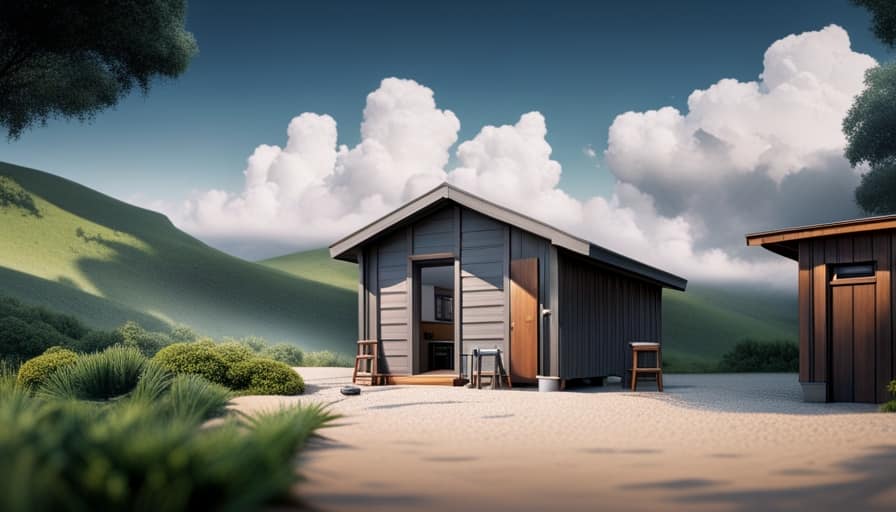
Recently, I have been bothered by these annoying little flies in my home, and I must say, they are really starting to get on my nerves!
But fear not, because I’ve done my research and I’m here to share some expert tips on how to get rid of those tiny flies once and for all.
From identifying the different types of flies to using natural remedies and chemical solutions, I’ve got you covered.
So let’s dive in and bid farewell to these unwanted guests together!
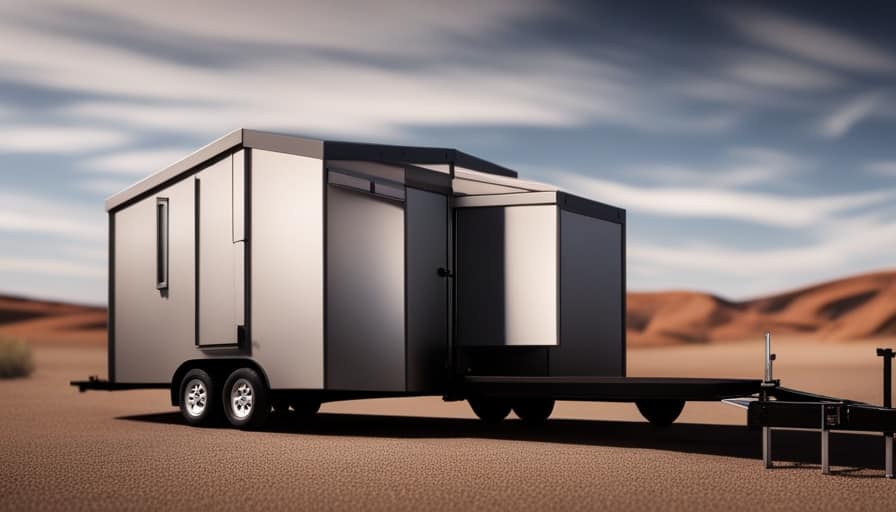
Key Takeaways
- Identifying the common types of tiny flies in your house is important for effective pest control.
- Tiny flies are attracted to moist and decaying organic matter, such as overripe fruits and rotting vegetables.
- Natural remedies, such as vinegar and dish soap solutions, can be used to eliminate tiny flies from your house.
- Preventing future infestations of tiny flies involves maintaining a clean environment, sealing cracks or openings, and storing perishable items properly.
Identifying the Common Types of Tiny Flies in Your House
I can easily identify the common types of tiny flies in my house by observing their physical characteristics and behavior. Flies are attracted to our homes for various reasons, including the presence of food, moisture, and waste. It’s important to note that these flies can pose health risks, as they can carry and spread disease-causing organisms.
To identify the types of flies, I first look at their size and color. For instance, fruit flies are small and have a tan or brown color. Drain flies, on the other hand, are gray or black and have a fuzzy appearance.
Understanding the Reasons Why Tiny Flies Infest Your Home
To understand why tiny flies infest your home, it’s important to consider their attraction to certain conditions and factors within your living space.
These flies, commonly known as fruit flies or drain flies, are attracted to moist and decaying organic matter. They seek out common breeding grounds such as overripe fruits, rotting vegetables, and damp areas in your kitchen or bathroom.
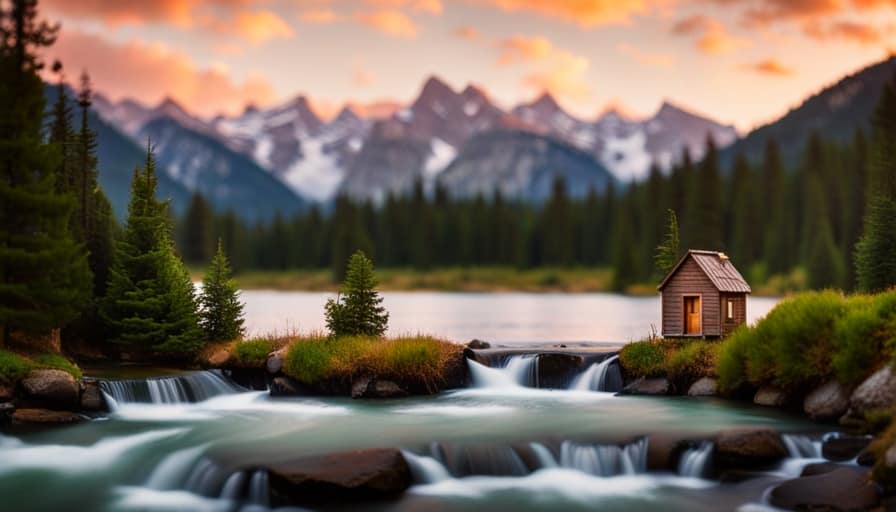
These tiny flies are also drawn to standing water in sinks, drains, and garbage disposals. Signs of a fly infestation include the presence of numerous flies hovering around these areas, as well as the sighting of their larvae or pupae.
It’s crucial to address these conditions and remove any potential breeding grounds to effectively eliminate the infestation and prevent future occurrences.
Natural Remedies to Eliminate Tiny Flies From Your House
One effective way to eliminate tiny flies from your house is by using a combination of vinegar and dish soap. This homemade vinegar fly spray is a non-toxic and practical solution to get rid of those pesky insects.
Here’s how you can make it:
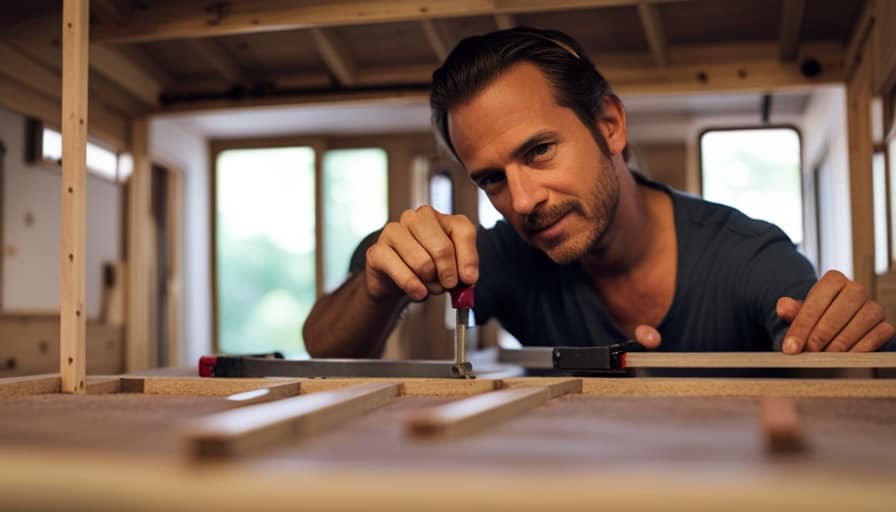
- Mix equal parts of vinegar and water in a spray bottle.
- Add a few drops of dish soap to the mixture. The soap helps to break the surface tension of the liquid, making it easier for the flies to drown.
- Shake the bottle gently to ensure the ingredients are well combined.
- Spray the solution directly onto the flies or in areas where they’re commonly found, such as near windows or fruit bowls.
This natural fly spray isn’t only effective but also safe for your family and pets. It traps and kills the flies without the use of harmful chemicals.
Give it a try and say goodbye to those tiny flies in your house!
Using Chemical Solutions to Get Rid of Tiny Flies in Your Home
Bleach is a strong and effective chemical solution that can help eliminate tiny flies in your home. Chemical solutions, such as bleach, can be highly effective in eliminating tiny flies. The strong properties of bleach make it a powerful tool for killing flies and destroying their breeding grounds. However, it’s important to use caution when using chemical solutions, as they can be harmful to humans and pets if not used properly.
When comparing chemical solutions to natural remedies for getting rid of tiny flies in your house, it’s important to consider their effectiveness.
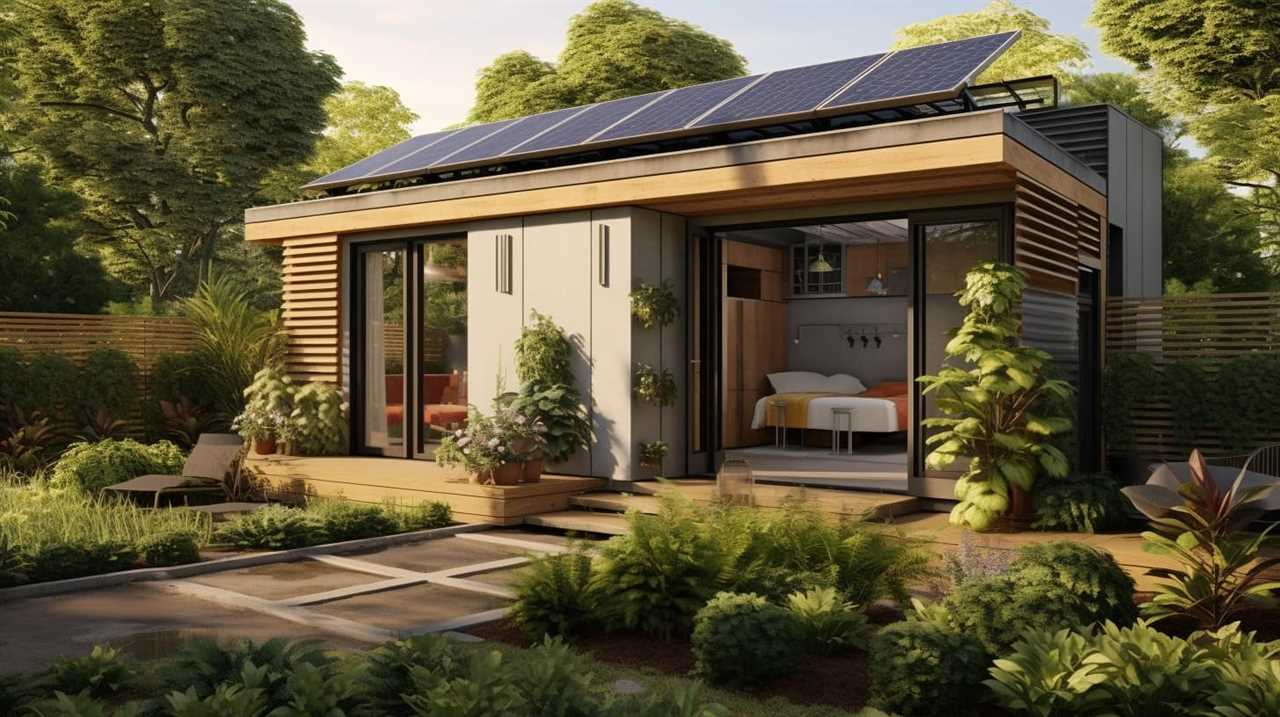
In the next section, we’ll discuss methods for preventing future infestations of tiny flies in your house.
Preventing Future Infestations of Tiny Flies in Your House
I can take steps to prevent future infestations of tiny flies in my house by implementing proper sanitation practices. By maintaining a clean environment, I can greatly reduce the chances of reinfestation. Here are three key practices to incorporate:
-
Regularly clean and sanitize all areas of the house, especially the kitchen and garbage disposal areas. Empty and clean trash cans frequently to prevent any organic matter from attracting flies.
-
Seal any cracks or openings in doors, windows, and screens to prevent flies from entering the house. Repair any damaged screens to ensure they’re intact and functioning properly.
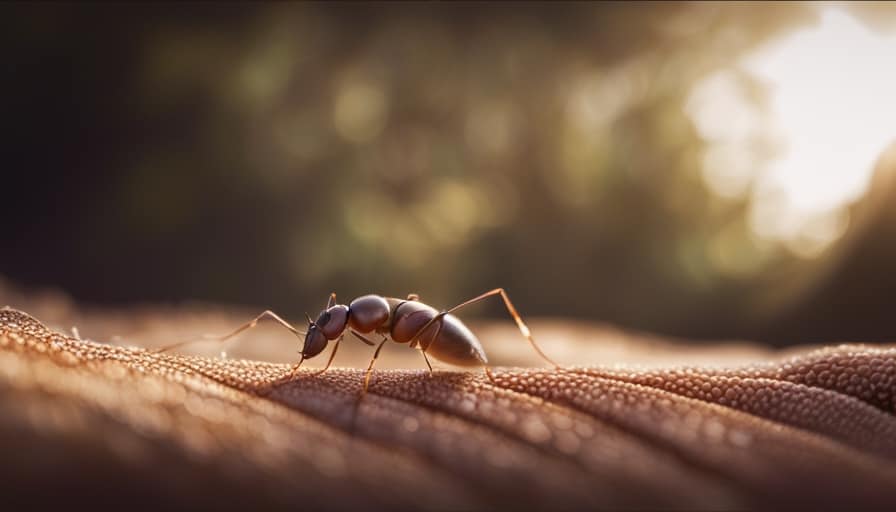
-
Store fruits, vegetables, and other perishable items in sealed containers or in the refrigerator. Flies are attracted to the odors of decaying food, so keeping it properly stored will deter them.
Frequently Asked Questions
How Do Tiny Flies Affect My Health?
Tiny flies can pose health risks, as they can carry bacteria and pathogens that can cause illnesses. To avoid health issues, it’s important to keep your house clean, dispose of trash properly, and eliminate any standing water where they can breed.
Can Tiny Flies Damage My Property?
Tiny flies can indeed cause damage to your property. Their larvae can infest and feed on organic materials, such as wood, causing structural damage over time. It’s important to address the issue promptly to prevent further harm.
Are Tiny Flies Attracted to Specific Food Sources?
Tiny flies are often attracted to specific food sources, such as overripe fruits or decaying organic matter. Understanding their breeding habits and implementing effective prevention methods, like proper sanitation and sealing entry points, can help keep them out of the house.

How Long Does It Take for Natural Remedies to Eliminate Tiny Flies?
In my experience, the speed of effectiveness of natural remedies versus chemical solutions for eliminating tiny flies can vary. While some natural remedies may work quickly, others may take longer to fully eliminate the flies. It’s important to be patient and consistent in your efforts.
Are There Any Long-Term Effects of Using Chemical Solutions to Get Rid of Tiny Flies?
Using chemical solutions to eliminate tiny flies in your house can have long-term environmental impacts. Consider using alternative methods like natural remedies or traps that are safer and more sustainable for the ecosystem.
Conclusion
In conclusion, it’s evident that tiny flies can be a nuisance in our homes. By understanding their types and reasons for infestation, we can effectively eliminate them using natural remedies or chemical solutions.
However, it’s crucial to prevent future infestations by maintaining cleanliness and proper waste management. Rest assured, with the right knowledge and approach, you can bid farewell to these pesky insects and enjoy a fly-free home environment.
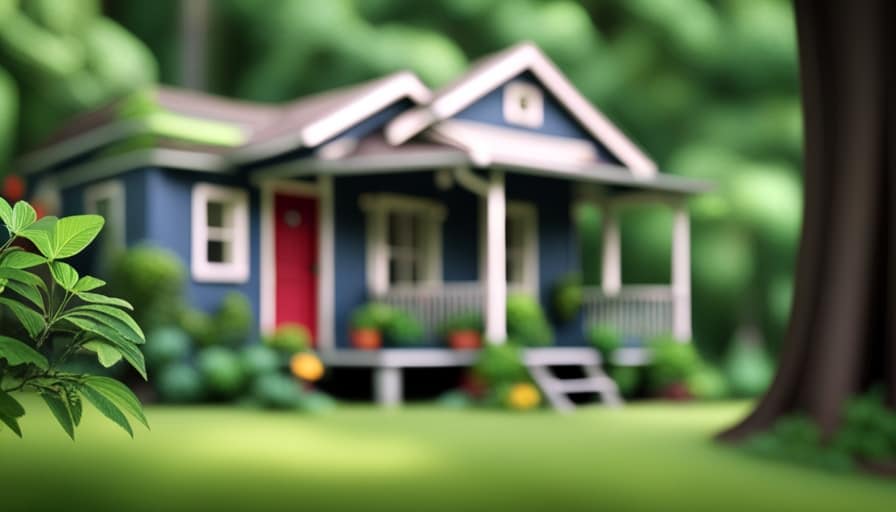
I’m Theodore, and I love tiny houses. In fact, I’m the author of Tiny House 43, a book about tiny houses that are also tree houses. I think they’re magical places where imaginations can run wild and adventures are just waiting to happen.
While tree houses are often associated with childhood, they can be the perfect adult retreat. They offer a cozy space to relax and unwind, surrounded by nature. And since they’re typically built on stilts or raised platforms, they offer stunning views that traditional homes simply can’t match.
If you’re looking for a unique and romantic getaway, a tree house tiny house might just be the perfect option.
Beginners Guides
How Do I Get Rid of Tiny Ants in My House

- Health risks: Are there any potential diseases that can be transmitted by ants in the house?
- Prevention methods: What are some effective ways to keep ants out of the house to avoid any health risks?
I have been dealing with these stubborn small ants in my home, and I’m sure you can empathize. It seems like I am stuck in an endless game of hide-and-seek with these little creatures.
But fear not, because I’ve done my research and I’m here to share some tried and true methods to get rid of them for good. From natural remedies to chemical solutions, I’ve got you covered.
So let’s roll up our sleeves and say goodbye to those pesky ants together!
Key Takeaways
- Identifying the type of ants in your house is important in order to effectively address the infestation issue.
- Understanding the behavior and nesting habits of tiny ants is essential in finding and eliminating their colonies.
- Natural remedies such as vinegar and water solution, essential oils, and cinnamon can help repel and eliminate tiny ants.
- If natural remedies don’t work, consider using chemical solutions or seeking professional pest control services for a safer and more comprehensive approach.
Identifying the Type of Ants in Your House
I personally find it helpful to identify the type of ants in my house by observing their behavior and physical features. Distinguishing characteristics play a crucial role in determining the species of ants present.
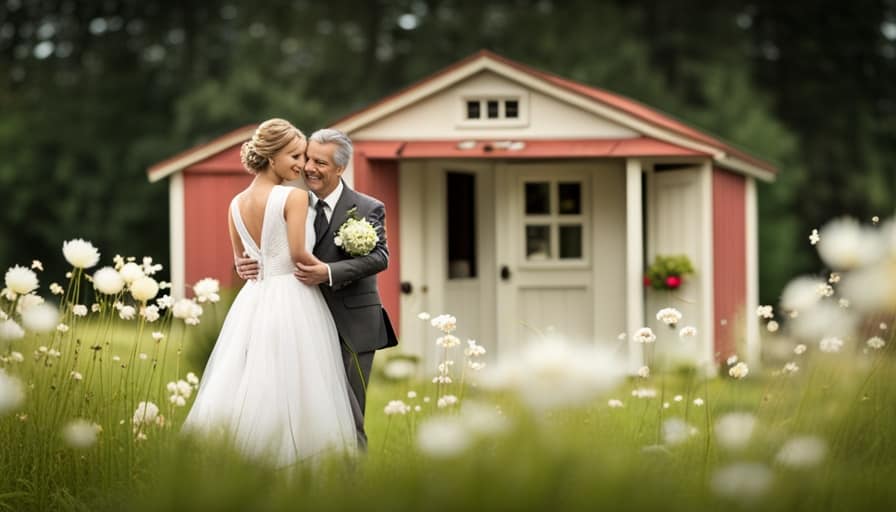
Some common types of household ants include pavement ants, odorous house ants, and pharaoh ants. Pavement ants are dark brown or black with parallel grooves on their heads and thoraxes. Odorous house ants emit a distinct odor when crushed, often described as a rotten coconut smell. Pharaoh ants are light yellow to reddish-brown and have two distinct nodes on their petioles.
In terms of common habitats, ants can be found in various areas of the house, including kitchens, bathrooms, and around food sources. Understanding the behavior and nesting habits of tiny ants is essential in effectively addressing the infestation issue.
Understanding the Behavior and Nesting Habits of Tiny Ants
There are several key factors to consider when understanding the behavior and nesting habits of tiny ants in your house.
These tiny creatures are social insects, living in colonies that can range from a few dozen to thousands of individuals. They communicate and cooperate through chemical signals and pheromones, which helps them locate food sources and establish trails.

When it comes to nesting, tiny ants can build their colonies in various locations, such as in wall voids, under floors, or even in potted plants. Understanding their nesting habits is crucial in effectively eliminating them from your house.
It’s important to note that while ants can be a nuisance indoors, they play a vital role in the ecosystem, helping to decompose organic matter and control other insect populations. However, their presence in food storage areas can contaminate and spoil food, making it necessary to address their infestation promptly and safely.
Natural Remedies to Get Rid of Tiny Ants in Your House
One effective natural remedy to eliminate tiny ants in your house is using a vinegar and water solution. Vinegar, with its strong odor, disrupts their scent trails and confuses them, making it difficult for them to navigate. To create the solution, mix equal parts of white vinegar and water in a spray bottle. Then, simply spray the solution directly onto the ants or their entry points.
Another natural remedy is using essential oils, such as peppermint, lemon, or tea tree oil. These oils have strong scents that repel ants. Mix a few drops of your chosen essential oil with water and spray it in areas where ants are present.
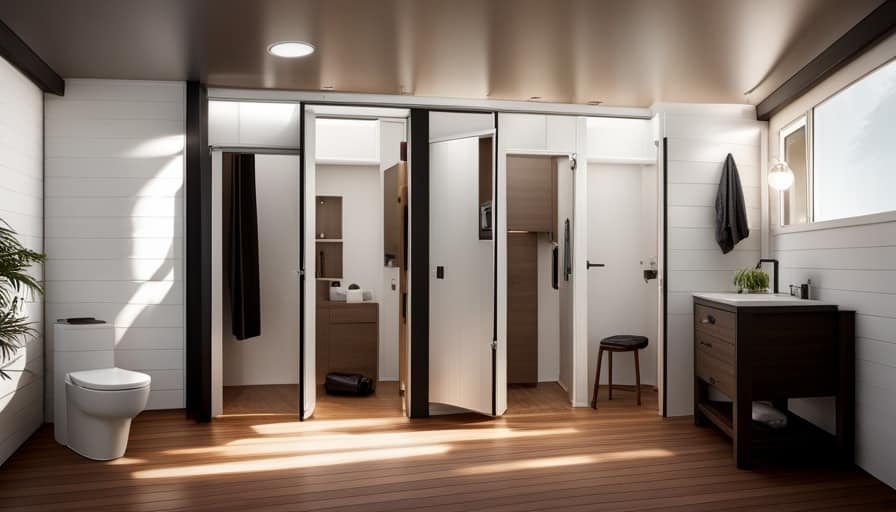
These natural remedies provide an eco-friendly and safe way to get rid of tiny ants in your house. However, if these methods don’t work, it may be necessary to consider chemical solutions for eliminating tiny ants.
Chemical Solutions for Eliminating Tiny Ants
If you’re dealing with a persistent infestation of tiny ants in your house, using insecticide sprays can be an effective solution to eliminate them. However, it is important to consider non-toxic alternatives and professional pest control services for a safer and more comprehensive approach.
| Chemical Solution | How it Works | Pros | Cons |
|---|---|---|---|
| Insecticide sprays | Kills ants on contact | – Easy to use – Widely available – Immediate results |
– Chemical exposure – Harmful to pets and children – Potential environmental impact |
While insecticide sprays can quickly kill ants, they may pose risks to your health and the environment. If you prefer non-toxic alternatives, consider using natural repellents like vinegar, lemon juice, or essential oils. These substances are less harmful and can help deter ants from entering your home.
Another option is to hire professional pest control services. They have the expertise and specialized equipment to effectively eliminate ant infestations. Professionals can also assess the extent of the problem and provide long-term solutions to prevent future infestations.
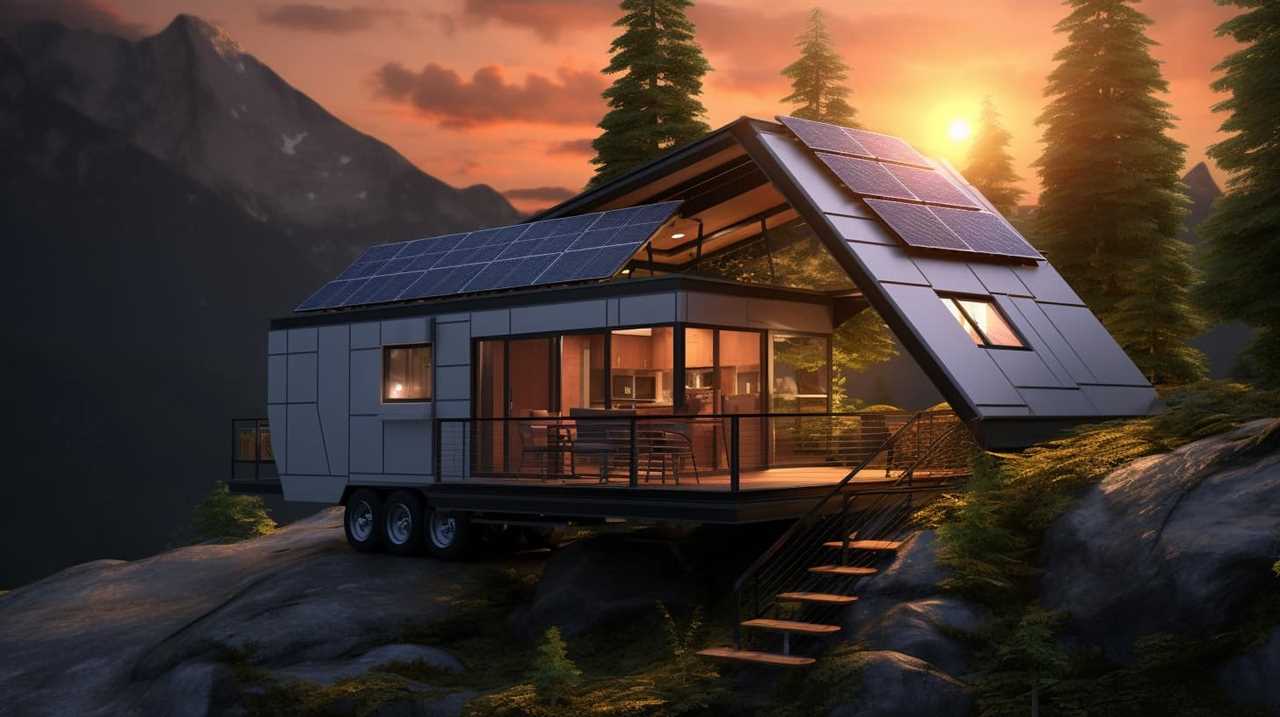
Preventing Future Infestations: Tips and Tricks
When I encountered a persistent infestation of tiny ants in my house, I took proactive steps to prevent future infestations. Here are some effective ant proofing techniques for your home and long-term strategies for keeping ants out:
-
Seal cracks and crevices: Inspect your house for any openings where ants can enter, such as gaps around doors, windows, and pipes. Use caulk or weatherstripping to seal these entry points.
-
Keep your house clean: Clean up food and drink spills promptly, and store food in airtight containers. Wipe down countertops and sweep floors regularly to remove any crumbs or residue that may attract ants.
-
Remove potential ant habitats: Trim back vegetation that’s in contact with your house, as ants can use it as a bridge to enter. Also, keep firewood and other outdoor items away from the foundation.

-
Use natural deterrents: Certain scents like peppermint, cinnamon, and vinegar can repel ants. Spray these substances around entry points or wipe down surfaces to discourage ants from entering.
Frequently Asked Questions
How Do I Get Rid of Ants in My Garden?
To get rid of ants in my garden, I use organic pest control methods and natural ant repellents. These methods are effective in keeping ants away and maintaining a healthy garden environment.
Can I Use Vinegar to Kill Ants?
Yes, vinegar can be used to kill ants. However, there are also other natural ant repellents that you can consider using as alternatives to vinegar.
What Should I Do if I Have a Severe Ant Infestation?
If I have a severe ant infestation, I would first focus on prevention tips such as sealing entry points and removing food sources. If the problem persists, I would consider professional ant extermination options for effective and long-lasting results.

Are There Any Health Risks Associated With Ants in the House?
There are potential health risks associated with ants in the house. They can contaminate food, spread bacteria, and even cause allergies. It’s important to take preventive measures to avoid these risks.
Can I Use Essential Oils to Repel Ants?
I find that using essential oils for ant control can be effective. However, it’s important to consider the pros and cons of natural ant repellents. While they are safe and eco-friendly, they may not be as potent as chemical options.
Conclusion
In conclusion, by identifying the type of ants in your house, understanding their behaviors and nesting habits, and implementing natural or chemical remedies, you can effectively get rid of tiny ants.
However, prevention is key to avoiding future infestations. Just as a fortress protects its kingdom from invaders, taking proactive measures will safeguard your home from these pesky pests.
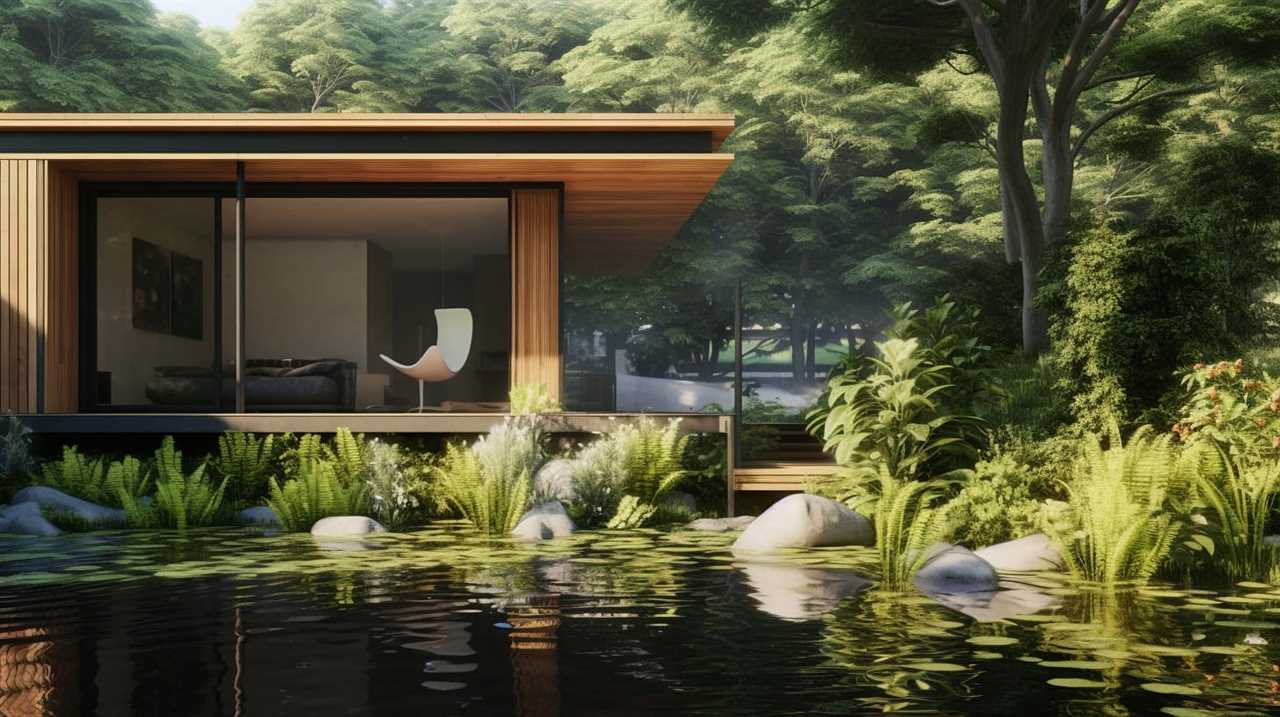
Stay vigilant and maintain cleanliness to ensure a ant-free environment.
I’m Theodore, and I love tiny houses. In fact, I’m the author of Tiny House 43, a book about tiny houses that are also tree houses. I think they’re magical places where imaginations can run wild and adventures are just waiting to happen.
While tree houses are often associated with childhood, they can be the perfect adult retreat. They offer a cozy space to relax and unwind, surrounded by nature. And since they’re typically built on stilts or raised platforms, they offer stunning views that traditional homes simply can’t match.
If you’re looking for a unique and romantic getaway, a tree house tiny house might just be the perfect option.
Beginners Guides
How Cheap Can You Build a Tiny House

Constructing a small house is akin to figuring out a puzzle – it can be difficult, but the payoff is valuable. As someone who enjoys discovering inventive answers, I sympathize with the longing to create a gorgeous home without breaking the bank.
In this article, we’ll explore the factors that affect the cost of building a tiny house and discover budget-friendly materials and labor-saving strategies. Join me on this journey to uncover just how cheap you can build your dream tiny house.
Key Takeaways
- Choosing the right location in a rural area with lower land prices and fewer building restrictions can significantly affect the cost of building a tiny house.
- Using alternative building methods such as reclaimed materials or repurposed items can help reduce costs.
- Implementing cost-saving techniques and building on a budget are important factors in building a cheap tiny house.
- Utilizing budget-friendly building materials, such as affordable insulation options and low-cost flooring alternatives, can also contribute to building a cheap tiny house.
Factors Affecting the Cost of Building a Tiny House
What are the factors that affect the cost of building a tiny house?
When it comes to building a tiny house on a budget, there are several cost-saving techniques and alternative building methods that can significantly impact the overall cost.
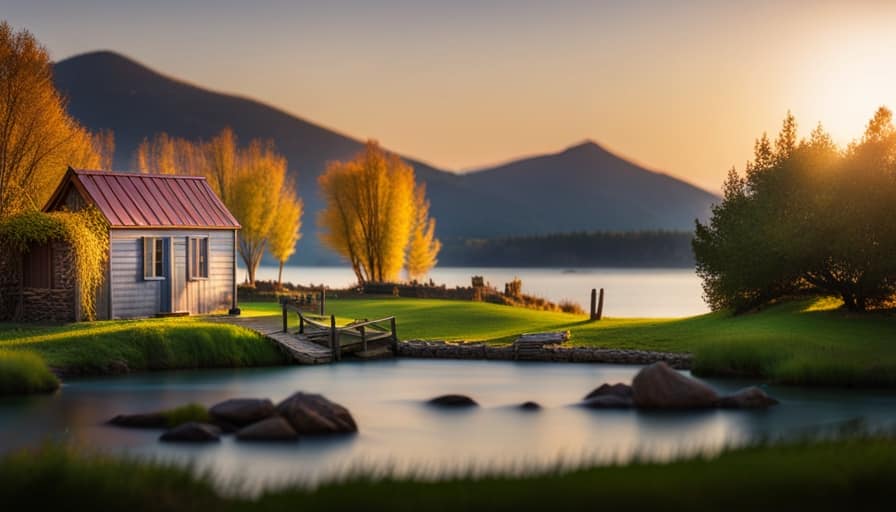
One of the main cost-saving techniques is choosing the right location. Building in a rural area with lower land prices and fewer building restrictions can help keep costs down.
Another factor that affects the cost is the size and design of the tiny house. The simpler the design, the more cost-effective it will be.
Additionally, using alternative building methods such as reclaimed materials or repurposed items can also help reduce costs.
By considering these factors and implementing cost-saving techniques, it’s possible to build a tiny house on a budget.
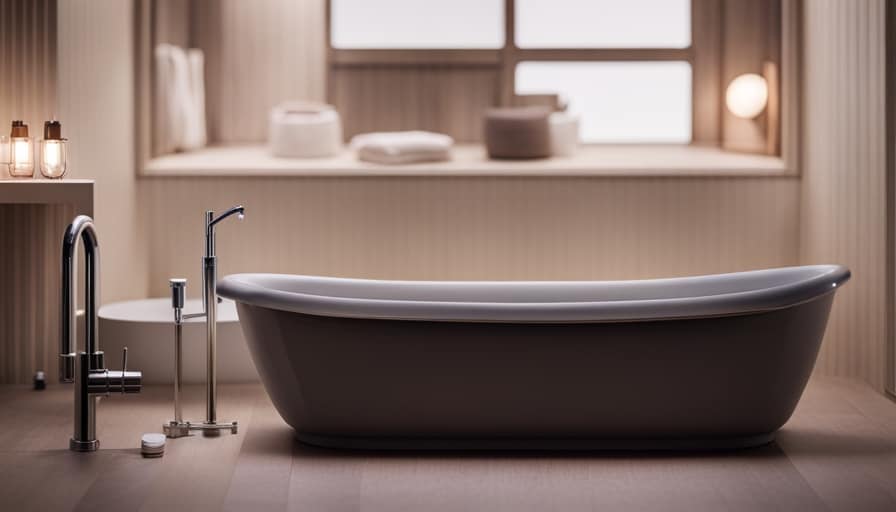
Transitioning into the subsequent section about budget-friendly tiny house building materials, let’s explore how the choice of materials can further impact the overall cost.
Budget-Friendly Tiny House Building Materials
When it comes to building a tiny house on a budget, I can find affordable building materials that will help keep costs down. One area where I can save money is by choosing affordable insulation options. Instead of expensive spray foam insulation, I can opt for alternatives such as fiberglass batts or rigid foam boards. These options are cost-effective and still provide good insulation for the tiny house. Additionally, I can consider low-cost flooring alternatives to save money. Instead of hardwood or tile, I can use vinyl plank flooring or laminate flooring, which are both affordable and durable. By making smart choices when it comes to insulation and flooring, I can build a budget-friendly tiny house without compromising on quality.
| Affordable Insulation Options | Low Cost Flooring Alternatives |
|---|---|
| Fiberglass batts | Vinyl plank flooring |
| Rigid foam boards | Laminate flooring |
Strategies for Saving Money on Tiny House Design
To save money on my tiny house design, I can employ cost-saving strategies such as utilizing multipurpose furniture and maximizing storage space. By incorporating cost-effective design options and implementing DIY tiny house building techniques, I can create a functional and affordable living space.
One key strategy is to choose furniture that serves multiple purposes, such as a sofa that can be converted into a bed or a dining table that can be folded away when not in use. This not only saves money on buying separate pieces of furniture but also maximizes the use of limited space.
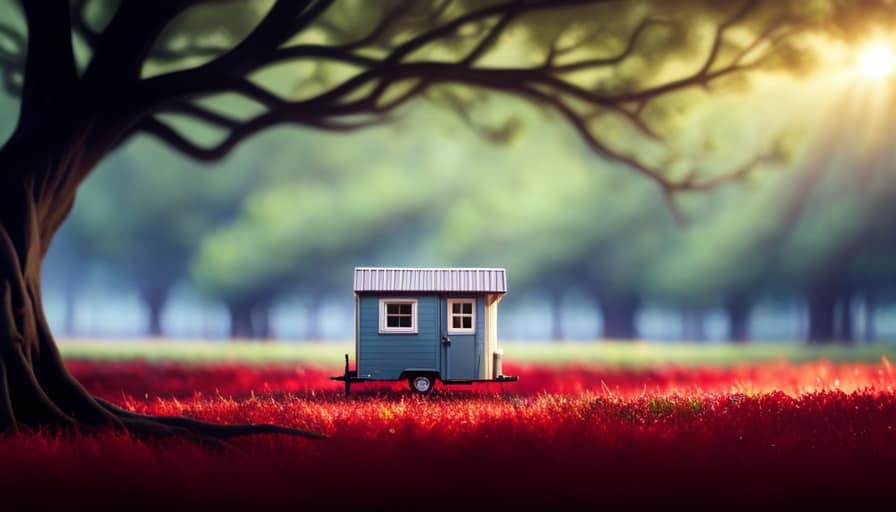
Another cost-saving strategy is to maximize storage space by utilizing built-in shelving, under-bed storage, and wall-mounted organizers. This eliminates the need for additional storage furniture and keeps the space clutter-free.
Creative Ways to Reduce Labor Costs in Tiny House Construction
I can significantly reduce labor costs in tiny house construction by hiring a small team of skilled workers instead of a large crew. This approach allows for effective coordination and streamlined communication, resulting in increased efficiency and reduced labor hours.
Here are some creative ways to further reduce labor costs in tiny house construction:
-
Utilize DIY construction techniques: Encourage the use of DIY construction techniques, where homeowners can actively participate in the building process. This not only reduces labor costs but also creates a sense of ownership and satisfaction.
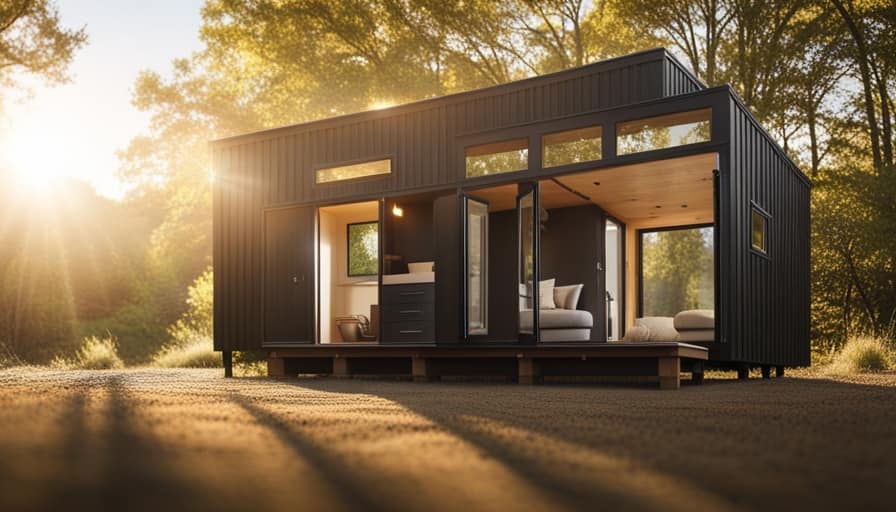
-
Incorporate alternative energy sources: Explore the use of alternative energy sources such as solar panels or wind turbines. By integrating these systems during the construction phase, you can avoid additional labor costs associated with retrofitting.
-
Optimize material usage: Carefully plan and optimize the use of materials to minimize waste. This can be achieved by accurately measuring and cutting materials, as well as repurposing leftover materials for other parts of the project.
-
Prioritize efficient design: Focus on designing a space that maximizes functionality and minimizes unnecessary labor-intensive features. This includes thoughtful space planning, utilizing multipurpose furniture, and incorporating efficient storage solutions.
Implementing these strategies won’t only help reduce labor costs but also contribute to a sustainable and budget-friendly tiny house construction process.
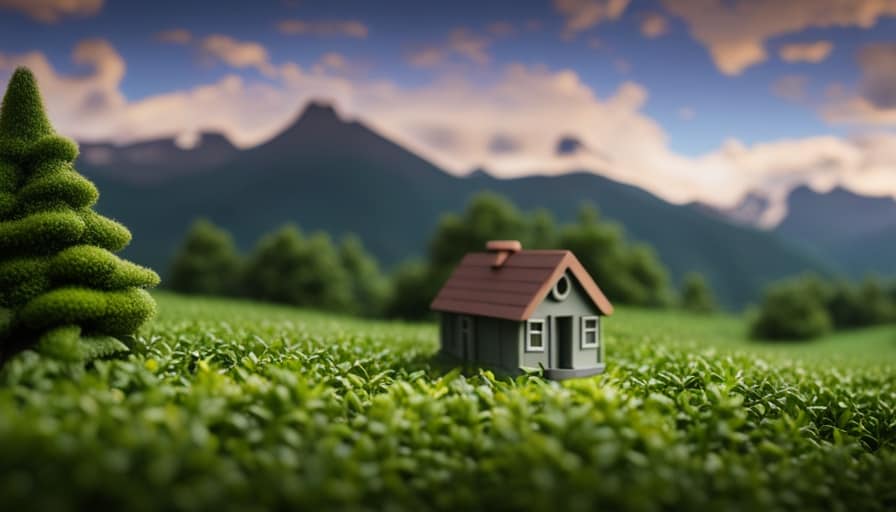
Tips for Finding Affordable Land for Your Tiny House
By researching online listings and networking with local real estate agents, I can easily find affordable land for my tiny house. It is important to explore alternative financing options for purchasing land for a tiny house to keep costs low. One option is owner financing, where the seller acts as the lender and allows you to make monthly payments instead of obtaining a traditional mortgage. Another option is crowdfunding, where you can raise funds from a community of supporters who believe in your tiny house project. Additionally, negotiating with local municipalities for reduced fees and regulations for tiny house living can save you money in the long run. Some municipalities may be open to creating special zoning or permitting regulations for tiny houses, making it easier and more affordable to live in them.
| Financing Options | Benefits |
|---|---|
| Owner Financing | Lower interest rates, flexible payment terms |
| Crowdfunding | Community support, no need for traditional loans |
| Negotiating with Local Municipalities | Reduced fees, simplified regulations |
Finding affordable land for your tiny house is a crucial step in building your dream home while staying within your budget. With the right research, networking, and negotiation skills, you can make your tiny house dreams a reality.
Frequently Asked Questions
What Are the Most Common Mistakes to Avoid When Building a Tiny House on a Tight Budget?
Common pitfalls to avoid when building a tiny house on a tight budget include overestimating DIY skills, not researching local codes and regulations, and not budgeting for unexpected expenses. Cost saving tips include using reclaimed materials and prioritizing essential features.
Are There Any Financing Options Available for Building a Tiny House?
Financing options for building a tiny house include personal loans, RV loans, and construction loans. Pros include flexibility, ownership, and the opportunity to live mortgage-free. Cons may include higher interest rates and stricter qualification requirements.
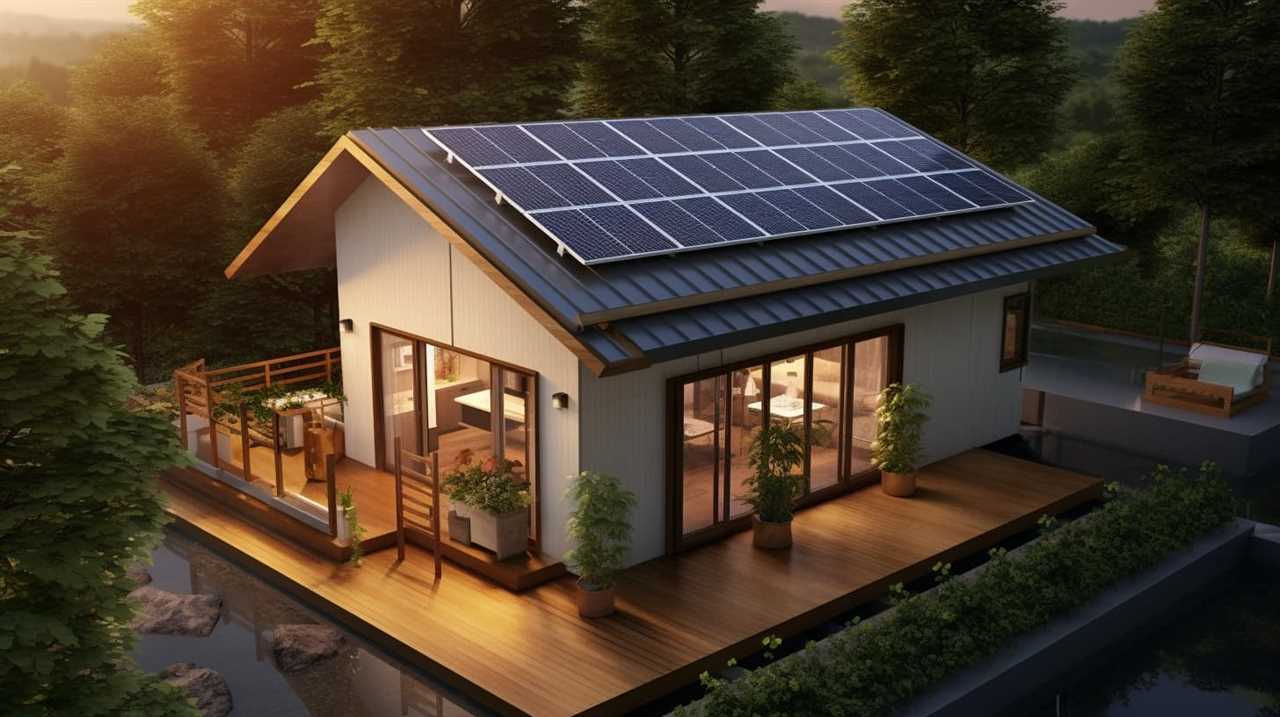
How Much Does It Cost to Maintain a Tiny House on a Yearly Basis?
Maintaining a tiny house on a yearly basis can be cost-effective. By embracing the benefits of living in a tiny house vs. a traditional home and following tips for minimizing maintenance costs, I can save money and enjoy a simpler lifestyle.
Can You Build a Tiny House Using Recycled or Salvaged Materials?
Using recycled and salvaged materials for a tiny house not only saves money, but also gives a sense of purpose and accomplishment. It’s a creative way to build sustainably and reduce waste while creating a unique and personalized home.
Are There Any Legal Restrictions or Regulations to Consider When Finding Land for a Tiny House?
When finding land for a tiny house, it’s important to consider legal restrictions and zoning regulations. Land requirements vary, and financing options may be limited. Maintenance costs can be lower, and eco-friendly building materials are often used.
Conclusion
In conclusion, building a tiny house can be an affordable and cost-effective option for those looking to downsize or live a more minimalist lifestyle. By considering factors such as materials, design strategies, and labor costs, it’s possible to build a tiny house on a tight budget.

With a little creativity and resourcefulness, you can achieve your dream of owning a tiny house without breaking the bank. So why wait? Start planning and building your own tiny house today!
I’m Theodore, and I love tiny houses. In fact, I’m the author of Tiny House 43, a book about tiny houses that are also tree houses. I think they’re magical places where imaginations can run wild and adventures are just waiting to happen.
While tree houses are often associated with childhood, they can be the perfect adult retreat. They offer a cozy space to relax and unwind, surrounded by nature. And since they’re typically built on stilts or raised platforms, they offer stunning views that traditional homes simply can’t match.
If you’re looking for a unique and romantic getaway, a tree house tiny house might just be the perfect option.
-

 Beginners Guides2 weeks ago
Beginners Guides2 weeks agoHow To Buy A Tesla Tiny House
-

 Energy Efficiency2 months ago
Energy Efficiency2 months agoBest Tiny Homes For Cold Climates
-

 Beginners Guides2 weeks ago
Beginners Guides2 weeks agoTiny House Nation Where Are They Now Stephanie
-

 Tiny House Resources (e.g., legalities, cost, insurance, FAQs)2 months ago
Tiny House Resources (e.g., legalities, cost, insurance, FAQs)2 months agoDo Tiny Homes Need Planning Permission?
-

 Beginners Guides3 weeks ago
Beginners Guides3 weeks agoFrom The Show Tiny House Nation How Many Keep Their Tiny House?
-

 Beginners Guides2 months ago
Beginners Guides2 months agoUsing a Climbing Net For Treehouse Construction
-

 Beginners Guides2 months ago
Beginners Guides2 months agoHow to Build a Treehouse Without Drilling Into the Tree
-
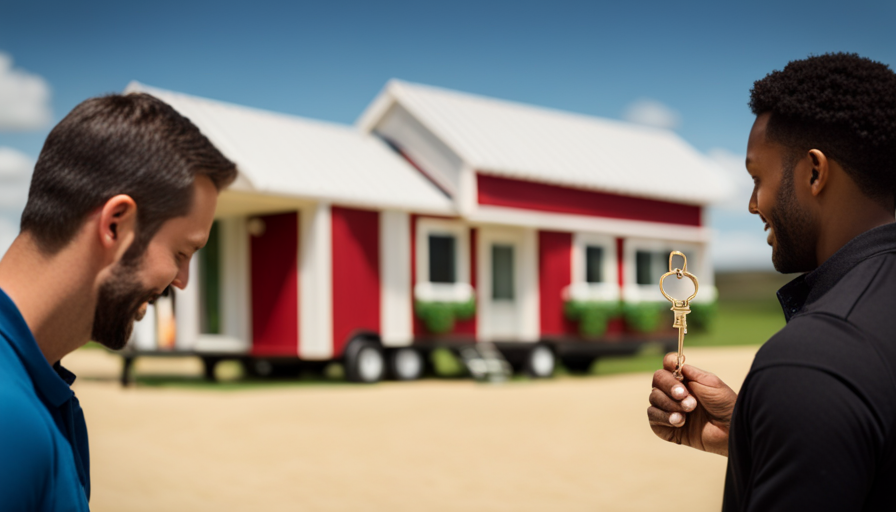
 Beginners Guides4 weeks ago
Beginners Guides4 weeks agoTiny House Nation Who Pays For The Houses




